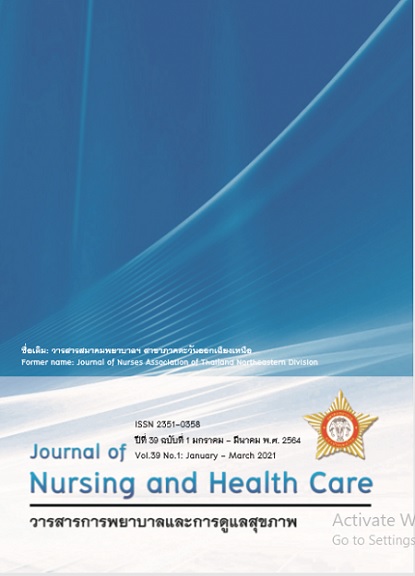ผล ผลของโปรแกรมสร้างเสริมศักยภาพบทบาทมารดาโดยยึดครอบครัว เป็นศูนย์กลางต่อการรับรู้การสนับสนุนของครอบครัว และความสำเร็จ ในการดำรงบทบาทมารดาของมารดาวัยรุ่นครรภ์แรก
คำสำคัญ:
มารดาวัยรุ่น, บทบาทมารดา, การสนับสนุนของครอบครัวบทคัดย่อ
การวิจัยครั้งนี้เป็นการวิจัยกึ่งทดลองแบบ 2 กลุ่มวัดครั้งเดียวหลังการทดลอง มีวัตถุประสงค์เพื่อศึกษาผลของโปรแกรม
สร้างเสริมศักยภาพบทบาทมารดาโดยยึดครอบครัวเป็นศูนย์กลางต่อการรับรู้การสนับสนุนของครอบครัว และความสำเร็จ
ในการดำรงบทบาทมารดาของมารดาวัยรุ่นครรภ์แรก 27 รายเป็นกลุ่มทดลอง 16 รายและกลุ่มควบคุม 11 ราย เครื่องมือ
การวิจัย ประกอบด้วย โปรแกรมสร้างเสริมศักยภาพบทบาทมารดาโดยยึดครอบครัวเป็นศูนย์กลางใช้ระยะเวลา 45 วัน
เก็บข้อมูลโดยใช้แบบสอบถามที่ผู้วิจัยสร้างขึ้นเองผ่านการตรวจสอบจากผู้เชี่ยวชาญ ได้ค่าดัชนีความตรงตามเนื้อหา
เท่ากับ 0.92 แบบสอบถามการรับรู้การสนับสนุนของครอบครัว และแบบสอบถามความสำเร็จในการดำรงบทบาทมารดา
ของมารดาวัยรุ่นครรภ์แรก หาความเที่ยงโดยใช้สัมประสิทธิ์แอลฟาครอนบาคเท่ากับ 0.90 และ 0.95 ตามลำดับ วิเคราะห์
ข้อมูลด้วยสถิติบรรยายการแจกแจงความถี่ ร้อยละ ค่าเฉลี่ย ค่าเบี่ยงเบนมาตรฐาน และสถิติที
ผลการวิจัย พบว่า หลังเข้าร่วมกิจกรรมตามโปรแกรมค่าเฉลี่ยการรับรู้การสนับสนุนของครอบครัวของกลุ่มทดลองสูง
กว่ากลุ่มควบคุมอย่างมีนัยสำคัญทางสถิติ (p<0.05) ( = 3.70, SD=0.333 และ =2.36, SD=0.670) และค่าเฉลี่ยความ
สำเร็จในการดำรงบทบาทมารดาของกลุ่มทดลองสูงกว่ากลุ่มควบคุมอย่างมีนัยสำคัญทางสถิติ (p<0.05) ( =4.08, SD= 0.279
และ =3.20, SD=0.145) ผลการวิจัยนี้แสดงให้เห็นว่าโปรแกรมสร้างเสริมศักยภาพบทบาทมารดาโดยยึดครอบครัวเป็น
ศูนย์กลางสามารถนำไปใช้เป็นแนวทางเพื่อสร้างเสริมศักยภาพบทบาทมารดาของมารดาวัยรุ่นครรภ์แรกได้ ดังนั้น
ควรสนับสนุนให้มีการจัดกิจกรรมตามโปรแกรมดังกล่าวเพื่อให้มารดาวัยรุ่นครรภ์แรกสามารถปฏิบัติบทบาทมารดาได้
อย่างเหมาะสม
Downloads
เอกสารอ้างอิง
2. Ministry of Public Health. Details of indicators, Ministry of Public Health 2018.Nonthaburi: Thailand; 2018.
3. Elsberry, C., Halley-Corrinet, A. The adolescent parent. In S H. Johnson (Eds.), Nursing Assessment and strategies for the family at risk high risk parenting. (2nd ed).Philadelphia: J.B. Lippincott.1986.
4. Bobak, I.M., Lowdermilk, D.L. & Jensen, M.D. Maternity nursing. (4 th ed.). St. Louis: The C.V.Mosby Company.1995.
5. Plodpluang U, Srichan A, Kaewpraphan S. Effect of breastfeeding promotion based on familial support program to knowledge, Attitude and behavior of postpartum mothers and familiar’s members. Phranakhon Rajabhat Research Journal (Science and Technology), 2016.11(2)41-52.
6. Oncharoen G, Sinsuksa N, Phahuwatanakorn W, Limruangrong P. Factors influencing maternal responsiveness in first-time mothers. J Nurs Sci Chulalongkorn Uni 2017; 29(2):87-98.
7. Satipan C, Sriarporn P, Sansiriphun N. Marital Relationship, Father-infant Attachment and Father Involvement in Postpartum Period. Nursing journal, 2016; 43(5):71-81.
8. Mercer, R. T., Hackley, K. C., &Bostrum, A. Social support of teenage mothers. Birth Defects, 1984; 20(5):245-290.
9. House, J. S. Work, Stress and Social Support. Reading Mass: Addison Wesley.1981.
10. Narong T, Supprasi P, Siriarunrat S. Effect of the maternal roles enhancing program on perception of family support and success in maternal role attainment among postpartum adolescents. The Journal of Faculty of Nursing Burapha University, 2014; 22(1):15-26.
11. Hattakitpanichakul K. Effect of teaching program with husband participation on maternal role adaptation in postpartum adolescent mothers. Thai journal of Nursing Council, 2012; 27(4):84-95.
12. Nativipattum J, Chinsuwan A .Effects of family-centered care program on adaptation of primipara with cesarean section and family support. Thailand Journal of Health Promotion and Environmental Health, 2016; 39(1):54-64.
13. Lertakyamanee J, Somprakit P, Santawat U. Clinical Research .Bangkok; Thailand: 2000.
14. Polgaya O, Choolert P.The Effect of the Maternal Roles Promoting Program by Family Support on Attitude and Maternal Roles. Journal of Health Research and Innovation, 2019; 2(1):131-142.
15.Butchan P, Chamusri S, Singhala K. Effects of Breastfeeding Promoting Program on Family Members Self-Efficacy and Breastfeeding Promotion Behavior in Community. Journal of Nursing and Health care, 2016; 34(4): 97-105.



